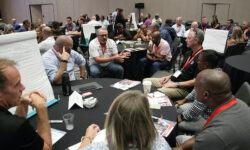How to Identify Nonverbal Indicators of Violence
Keeping an eye out for these types of actions and stopping a student before a situation escalates will enable school staff to maintain a safe environment.

Some nonverbal cues of violence are hands on the head, clenched fists, and removing clothing.
As children become more agitated and angry, they are unable to modify their behavior when they want to conceal their actions and intentions. Their body language will be warning signs of impending aggression.
These nonverbal clues can indicate when danger is near, but only if you know what to look for. If you can recognize indicators of violence at the onset of a situation, you will be able to react appropriately and, possibly, thwart the violence altogether.
Breaking down the human body into sections, here are the indicators of violence associated with the head, hands and lower body, as well as a person’s clothing.
Hands on Head
As a person becomes angry, frustration builds up. Anger is an emotion, and as such, it is processed in the brain. When the mind fills with hate, it will attempt to release the emotion in any way possible.
One way it will attempt this is to subconsciously instruct the person to raise his or her hands to his or her head. The hands will physically touch the head, or come very close to touching the head. Often, the person will rub his or her head and scalp. The hands will then become clenched as they “grasp a hold of the anger.”
The hands, holding the anger, will then move away from the head, releasing some of the emotional build-up. This is an immediate indicator that a person is becoming violent.
Clenched Fists, Hand Wringing
Clenched fists are a sign of anger that most people recognize. Other indicators include popping one’s knuckles, rubbing one’s hands together and hand wringing. A student performing these actions may be preparing his or her hands for a fight by loosening their muscles and tendons.
Hand-wringing is a subconscious action similar to raising the hands to the head in order to “grasp” anger. Once the anger has been grasped, the body needs a way of releasing the anger from the hands. Wringing one’s hands together, like drying them off on a towel, allows the anger to fall from the hands and away from the body. Finger pointing is another aggressive act.
Aggressive Lower Body Stance
When people prepare to fight, they will position the lower portion of their bodies in a stance that is suitable for fighting or fleeing. Their feet will be positioned shoulder-width apart and their knees will bend slightly. This allows people to punch using the force of their entire upper bodies, to kick, or to turn and run away.
The body will also blade to a person’s strong side. If the person is right-handed, he or she will move his or her left side forward, toward the perceived threat, and the right side back at an angle. Someone who is left-handed will take a stance in the opposite direction, with the right side forward.
If you appreciated this article and want to receive more valuable industry content like this, click here to sign up for our FREE digital newsletters!
 Leading in Turbulent Times: Effective Campus Public Safety Leadership for the 21st Century
Leading in Turbulent Times: Effective Campus Public Safety Leadership for the 21st Century
This new webcast will discuss how campus public safety leaders can effectively incorporate Clery Act, Title IX, customer service, “helicopter” parents, emergency notification, town-gown relationships, brand management, Greek Life, student recruitment, faculty, and more into their roles and develop the necessary skills to successfully lead their departments. Register today to attend this free webcast!







